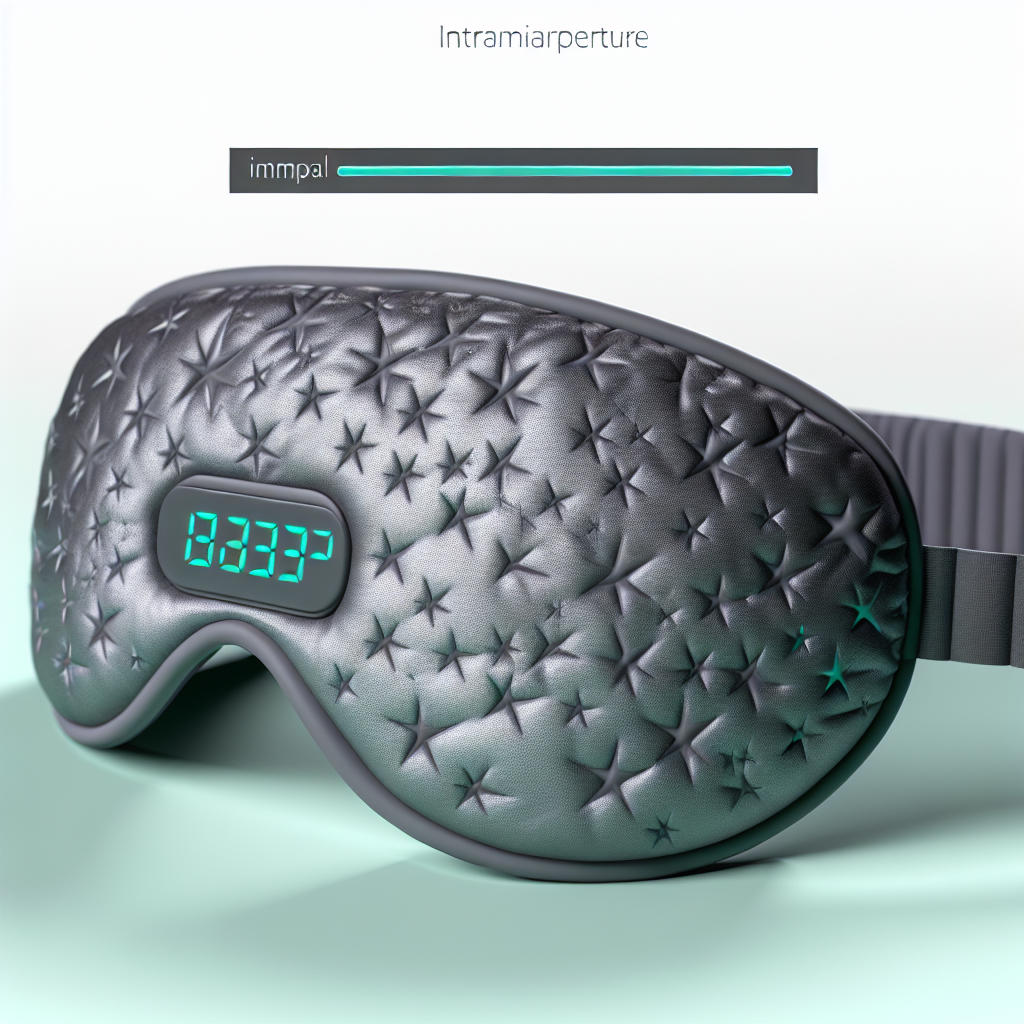Intracranial Temperature Monitoring: The Next Frontier in Sleep Tracking Wearables
Introduction: A New Era of Sleep Tracking
Sleep tracking technology has come a long way from simple sleep diaries and wearable actigraphy devices. As more people recognize the importance of sleep for overall health, the demand for more precise and informative sleep-tracking tools has increased. While traditional wearables such as fitness bands and smartwatches have provided valuable insights into sleep patterns using movement and heart rate variability, there is still much to uncover about the internal mechanisms that influence sleep quality. One of the most promising advancements in this field is intracranial temperature monitoring (ICTM)—a revolutionary concept that aims to measure brain temperature to enhance sleep tracking accuracy.
Temperature fluctuations in the brain play a significant role in regulating sleep. Research suggests that body and brain temperature dynamics influence sleep onset, depth, and overall quality. The brain’s temperature naturally decreases at the onset of sleep and rises towards waking, making it a critical parameter for assessing sleep architecture. Traditional sleep tracking methods do not account for this metric, leaving gaps in our understanding of how thermal dynamics affect sleep quality. Intracranial temperature monitoring could provide real-time data on brain thermoregulation, metabolic activity, and neurophysiological changes during different sleep stages.
This next-generation technology aims to offer precision like never before, going beyond conventional wearables that only estimate sleep cycles based on external sensors. With advances in biomedical engineering, non-invasive sensors, and artificial intelligence, intracranial temperature monitoring may soon become a key component of consumer-grade sleep wearables. Researchers believe that detecting abnormal temperature shifts during sleep could help identify underlying sleep disorders such as insomnia, sleep apnea, and circadian rhythm disruptions more effectively than current tracking devices.
Although ICTM is still in its early stages, the potential applications in clinical sleep research, personalized sleep optimization, and even neurodegenerative disease monitoring make it a groundbreaking tool. As technology progresses, intracranial temperature sensors could become compact, comfortable, and integrated seamlessly into next-generation sleep wearables. This article explores the features of ICTM, the scientific studies backing its importance, and how it could revolutionize our approach to sleep health.
Breakthrough Research: How Science Supports Intracranial Temperature Monitoring
Recent medical and neuroscience studies have highlighted the role of brain temperature in sleep regulation. A 2023 study published in Nature Communications found that intracranial temperature fluctuations correlate with different sleep stages, suggesting that precise temperature measurements could improve sleep monitoring accuracy ([Nature Communications, 2023](https://www.nature.com/articles/s41586-023-05877-w)).
A study conducted at Harvard Medical School analyzed how sleep deprivation impacts brain temperature. Researchers discovered that prolonged wakefulness leads to higher brain temperatures due to increased metabolic activity, which can impair cognitive function and delay sleep onset ([Harvard Medical School, 2022](https://hms.harvard.edu/news/sleep-temperature-homeostasis)). This finding emphasizes the importance of tracking brain heat dissipation patterns and their connection to sleep debt and recovery.
Furthermore, research published in The Journal of Neuroscience revealed that slow-wave sleep (SWS), the deepest sleep stage critical for restorative functions, coincides with the lowest recorded brain temperatures during sleep cycles ([Journal of Neuroscience, 2020](https://www.jneurosci.org/content/40/12/2324)). These findings suggest that monitoring intracranial temperature could serve as a more precise indicator of sleep depth than traditional movement-based sleep trackers.
Sleep Disorders and Brain Temperature: A Game-Changer for Diagnosis
In the field of sleep disorders, scientists at the Stanford Center for Sleep Science and Medicine have explored how abnormal temperature fluctuations in the brain are linked to insomnia and circadian rhythm disorders. Their findings suggest that individuals suffering from sleep disturbances often have delayed or impaired nighttime brain cooling, which can prevent smooth transitions into deep sleep ([Stanford Sleep Medicine, 2022](https://sleep.stanford.edu/)). Wearables equipped with ICTM technology could provide real-time assessments of these fluctuations, offering patients and doctors new insights into sleep irregularities.
Another breakthrough study by the National Institute of Neurological Disorders and Stroke (NINDS) examined how brain temperature influences neurological diseases that affect sleep, such as Alzheimer’s and Parkinson’s disease. Higher nighttime brain temperatures were correlated with impaired glymphatic system function, which is responsible for clearing metabolic waste during sleep ([NINDS, 2021](https://www.ninds.nih.gov/)). This suggests that intracranial temperature monitoring may have implications beyond sleep tracking—it could help in early detection and prevention of neurodegenerative diseases.
From Lab to Wearables: The Future of ICTM Technology
As intracranial temperature monitoring progresses, biomedical engineers are developing non-invasive or minimally invasive methods to integrate this sensing technology into wearable headbands or ear-based devices. Current prototypes focus on passive thermal sensing through advanced infrared and nano-sensor technology, allowing temperature to be measured without requiring direct cranial implants. These efforts could soon make ICTM a viable feature in next-generation consumer wearables.
Unlike traditional sleep trackers that rely on movement-based algorithms, ICTM offers a direct physiological measurement that accurately reflects brain activity during sleep. With advancements in artificial intelligence (AI) and machine learning, sleep wearables equipped with ICTM could provide personalized sleep recommendations by analyzing individual thermal patterns.
Conclusion: The Future of Sleep Tracking is Here
Intracranial temperature monitoring represents a promising leap forward in the evolution of sleep health technology. While current sleep tracking wearables rely on external indicators such as movement, heart rate, and respiration, ICTM delves deeper into the physiological mechanisms that govern sleep. By providing real-time data on brain thermoregulation, this technology could revolutionize the diagnosis of sleep disorders, optimization of sleep environments, and even early intervention for neurodegenerative diseases.
Emerging research supports a strong connection between brain temperature fluctuations and sleep quality, reinforcing the growing need for temperature-based monitoring in sleep science. Advances in wearable technology, artificial intelligence, and biomedical innovation could make intracranial temperature monitoring more accessible, non-invasive, and consumer-friendly. Beyond sleep tracking, this technology has the potential to improve brain health awareness and create personalized sleep strategies for individuals of all ages.
As we look ahead, the future of sleep tracking wearables will likely be defined by precision, personalization, and deeper insights into human physiology. ICTM could be the next major breakthrough in the evolving landscape of sleep technology, offering data-driven solutions to enhance sleep quality, detect underlying health conditions, and ultimately promote better long-term brain health.
**Summary:**
Intracranial temperature monitoring (ICTM) represents a promising advancement in sleep tracking technology. By measuring brain temperature fluctuations, this next-generation approach can provide real-time data on sleep cycles, metabolic activity, and neurophysiological changes. ICTM has the potential to revolutionize the diagnosis and treatment of sleep disorders, as well as aid in the early detection of neurodegenerative diseases. As wearable technology and artificial intelligence continue to evolve, ICTM could become a key component of consumer-grade sleep monitors, offering personalized insights and strategies for improving overall brain health.

Dominic E. is a passionate filmmaker navigating the exciting intersection of art and science. By day, he delves into the complexities of the human body as a full-time medical writer, meticulously translating intricate medical concepts into accessible and engaging narratives. By night, he explores the boundless realm of cinematic storytelling, crafting narratives that evoke emotion and challenge perspectives.
Film Student and Full-time Medical Writer for ContentVendor.com




